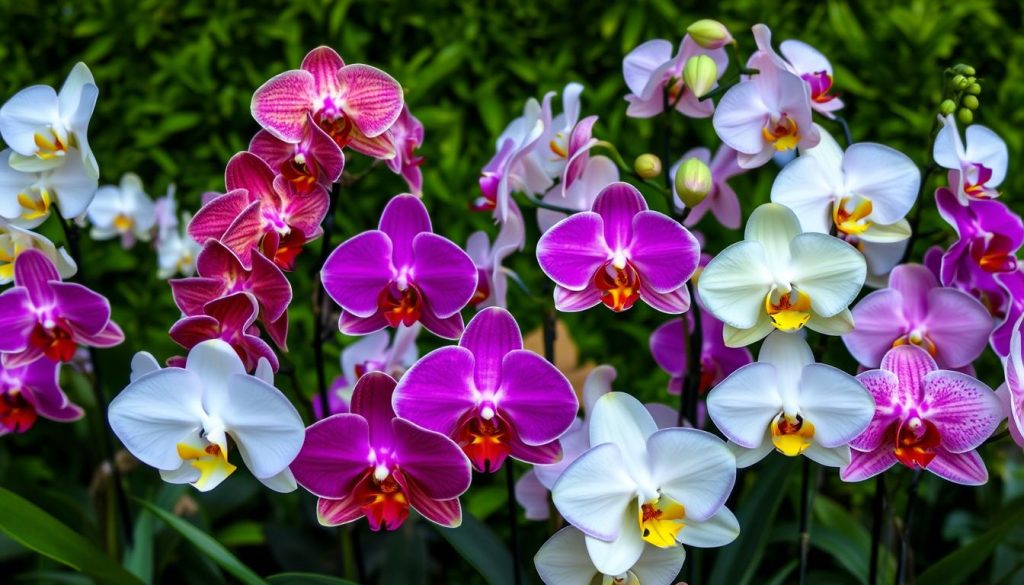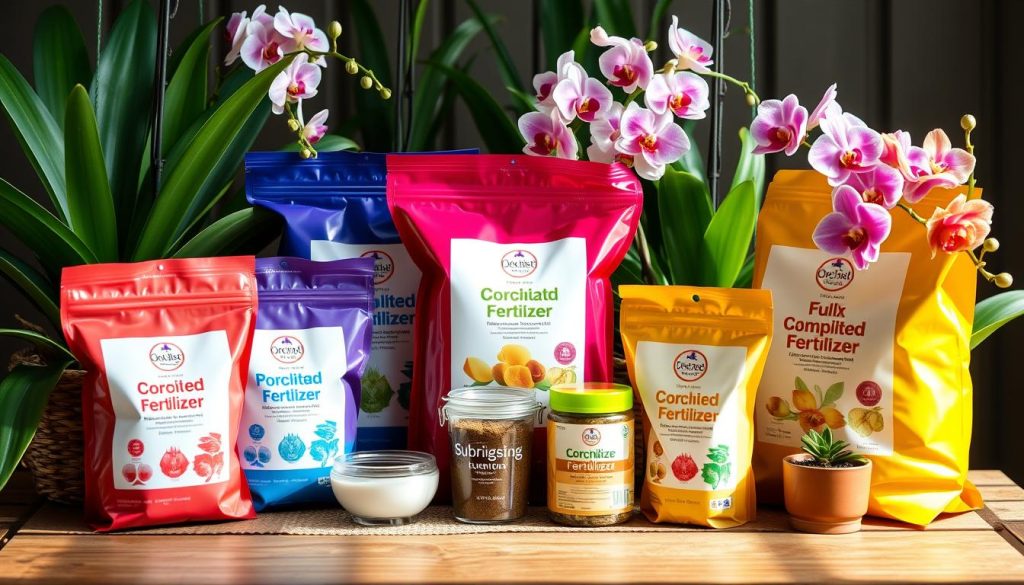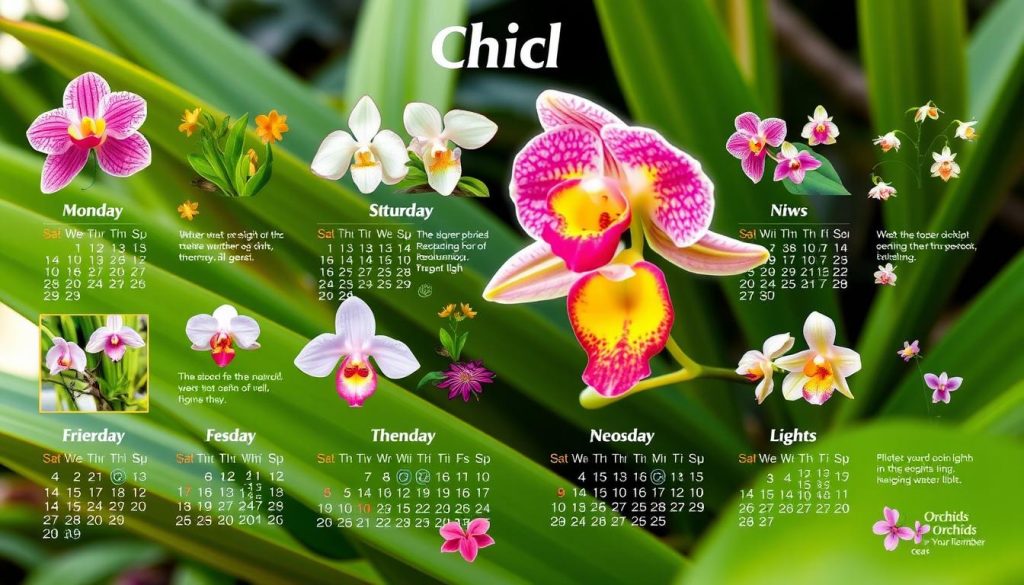Orchids are the stars of the plant world. They come in over 30,000 species and 200,000 hybrids. This makes the orchid world vast and fascinating.
Whether you’re an experienced gardener or new to plants, this guide is for you. It will help you grow these stunning flowers. Soon, your home or garden will be filled with orchid beauty.

Key Takeaways
- Discover the wide variety of orchid species and their unique characteristics
- Learn the essential requirements for keeping your orchids healthy and thriving
- Understand the differences between growing orchids indoors and outdoors
- Master the art of watering, fertilizing, and repotting to ensure optimal orchid care
- Explore effective methods for propagating and multiplying your orchid collection
Introduction to the Enchanting World of Orchids
Orchids are truly magnificent plants, known for their stunning blooms and captivating diversity. This section invites you to explore the fascinating world of orchids. Here, beauty, elegance, and rewards await those who cultivate these captivating specimens. Understanding the unique characteristics of different orchid species and hybrids is key to successful growth and thriving collections.
With over 25,000 known orchid species and more than 100,000 registered hybrids, the variety is truly astounding. From the graceful Phalaenopsis orchids native to Southeast Asia to the exotic Paphiopedilum slipper orchids, the orchid kingdom offers a vibrant spectrum of colors, shapes, and sizes. Some orchid varieties, like the Vanda genus, are renowned for their exceptional endurance, blooming for months on end.
Orchids have long been associated with beauty, love, and luxury in various cultures, particularly in Asia. They are revered for their symbolism of refinement and fertility. The creation of diamond orchids, where craftsmanship combines orchids with diamonds, further elevates their elegance and sophistication. Ethical considerations, such as the availability of lab-grown diamonds, ensure that orchid enthusiasts can make sustainable choices that align with their values.
Immerse yourself in the enchanting world of orchids and unlock the secrets to cultivating these magnificent plants successfully. Whether you’re a seasoned orchid grower or a newcomer to this captivating hobby, the journey ahead promises to be a truly rewarding experience.
Understanding Different Types of Orchids
The orchid family, Orchidaceae, is huge and diverse, with over 25,000 species worldwide. It includes popular houseplants and rare, exotic ones. Orchids fascinate many people.
Popular Indoor Orchid Species
Many orchids are great for indoor growing. They appeal to both new and seasoned growers. Phalaenopsis, Cattleya, Dendrobium, and Cymbidium are common ones. Each needs specific care to bloom well.
Rare and Exotic Varieties
Some orchids are easy to find, but others are rare and special. Aerangis, Ascocenda, and Brassavola are examples. They’re hard to grow but have stunning flowers. You can find them at special shows or in the wild.
Native American Orchids
Orchids aren’t just tropical. Many species are found in North, Central, and South America. Catasetum and Laelia orchids are examples. They show the variety of orchids in the Americas.
Orchids offer beauty for every gardener. You might love Phalaenopsis, Cattleya, or rare orchids. Knowing what each type needs helps you choose the best for your space.
Essential Growing Requirements for Healthy Orchids
To grow vibrant, long-lasting orchids, you need to know their special needs. Whether you’re new to orchids or have been growing them for years, learning the basics is key. It’s important for both orchid care and cultivation.
One key factor is watering. Watering too much is the top reason orchids fail. They need to dry out between waterings to avoid root rot. How often you water depends on the season and where you live.
Orchids also need the right temperature and humidity. They come from subtropical places where it’s humid. They like temperatures between 50 and 90 degrees Fahrenheit. They don’t like it too hot or too cold.
Getting the right light is also crucial. South and east-facing windows are best. Not enough light is a common reason orchids don’t bloom again. Proper fertilization is also important. It helps your orchids grow strong roots, healthy leaves, and beautiful flowers.
By knowing and meeting your orchids’ special needs, you can create the perfect place for them to grow. This way, they’ll reward you with their stunning blooms.
Selecting the Perfect Orchid for Your Environment
Choosing the right orchid for your home or office is crucial for successful care. Consider the climate, lighting, and space you have. This ensures your orchid thrives and blooms beautifully for years.
Climate Considerations
Orchids come from various climates. It’s key to pick an orchid that fits your local environment. For example, Phalaenopsis orchids love warm, humid places and do well in many homes. But, Cymbidium orchids need cooler temperatures and may struggle in hot, dry areas.
Light Requirements
Lighting is vital when choosing an orchid. Some, like Dendrobiums and Oncidiums, need bright sunlight. Others, such as Phalaenopsis and Paphiopedilums, prefer indirect light. Make sure your orchid gets the right amount of light.
Space and Location Factors
Think about the size and growth of different orchids. Larger ones, like Cattleyas, need more space. Smaller ones, like Ascocentrum, can fit in tight spots. Also, place your orchid where it gets the right temperature, humidity, and air.
By considering these factors, you can find the perfect orchid for your space. Enjoy the beauty and success of growing orchids.
Indoor vs Outdoor Orchid Cultivation
Orchids are known for their beauty and easy care. You can grow them indoors or outdoors, each with its own benefits. Knowing the differences between indoor and outdoor orchid care helps you choose the best way to grow your orchids.
If you grow orchids indoors, your home or office provides a stable environment. Plants like Phalaenopsis do well in moderate light and temperatures. But, it’s important to keep the humidity and watering right for healthy growth.
Outdoor orchid growing lets them enjoy natural sunlight and changes in the air. Some orchids, like Cattleya, love bright, filtered light and a bit wider temperature range. With the right start, outdoor orchids can grow strong and bloom beautifully with the seasons.
It doesn’t matter if you grow orchids indoors or outdoors, the right conditions are key. You need to water them regularly, fertilize them right, and watch out for pests and diseases. By knowing what your orchids need, you can create the best space for them to flourish, whether it’s inside or outside.
Proper Watering Techniques and Schedules
Watering orchids is key, as wrong methods can harm them a lot. More orchids die from bad watering than any other reason. Most orchids live in the air, needing their roots to breathe and get light. Too much water can rot the roots, while too little can dehydrate the plant.
Water Quality Requirements
It’s important to use clean water when watering orchids. Tap water can have harmful chemicals. So, using filtered or distilled water is best for your plants.
Seasonal Watering Adjustments
Orchids need different amounts of water at different times. In hot summer months, some like Vandas need water every day. But in cold winters, you should water less to avoid root rot.
Common Watering Mistakes to Avoid
- Overwatering: Keeping the soil too wet can rot the roots.
- Underwatering: Letting the soil dry out too much can stress the plant.
- Improper watering techniques: Not watering enough or letting water sit can harm the plant.
- Using unsuitable water sources: Tap water with chlorine or minerals is bad for orchids.
Keeping a good watering schedule is crucial for your orchids’ health. Knowing how much water each type needs and adjusting for the seasons helps them grow well. This way, your orchids can reach their best.
Soil and Potting Media for Orchids
Choosing the right potting media is key for orchid health. Orchids need special soil because of their unique roots. Knowing about orchid-specific mixes helps pick the best one for your plants.
Orchids thrive in mixes that drain well, like sphagnum moss and fir bark. These materials keep roots healthy by providing air and holding moisture. Orchids usually need a new pot every 1-2 years, but the mix can break down faster if the pot doesn’t drain well.
- Phalaenopsis orchids should be repotted every 1-2 years or when the potting media begins to smell.
- The roots of orchids may become tightly tangled, signaling the need for repotting.
- When repotting an orchid, it is recommended to use a pot 1-2 inches larger in diameter than the original pot.
Orchid potting materials can be organic or inorganic. Organic stuff like sphagnum moss and bark breaks down, giving plants nutrients. Inorganic stuff, like Styrofoam, doesn’t break down and might need extra nutrients.
Choosing between organic and inorganic materials affects nutrient supply, drainage, and root health. Orchid lovers should think about the environmental impact of their choices.
Mastering Orchid Repotting Techniques
Keeping your orchids healthy means repotting them sometimes. Knowing when to repot and following a guide can make it easy. Let’s explore how to master orchid repotting.
Signs It’s Time to Repot
Orchids need a fresh pot every two years. Look for these signs to know it’s time:
- Loss of leaves or weak stem growth
- Decomposing or discolored potting medium
- Overgrown roots that are trailing out of the pot
- Poor drainage or waterlogging issues
Step-by-Step Repotting Guide
Repotting orchids is easier when they’re not in bloom. Here’s how to do it right:
- Gather your supplies: a clean, sterile cutting tool, a slightly larger pot, and a fresh orchid potting mix.
- Gently remove the orchid from its current pot, taking care to avoid damaging the roots.
- Inspect the roots and trim any dead or damaged areas with your sterilized cutting tool.
- Place the orchid in the new pot, ensuring the plant is centered and the roots are positioned properly.
- Fill the pot with the fresh orchid potting mix, taking care not to pack it too tightly.
- Water the orchid thoroughly, following the specific watering guidelines for your orchid variety.
Post-Repotting Care
After repotting, your orchid needs the right care. Keep it out of direct sunlight for a few weeks. Water it sparingly, letting the potting medium dry a bit between waterings. With the right care, your orchid will thrive and bloom beautifully.
Fertilization and Nutrient Management
Keeping the right balance of nutrients is key for your orchids’ health and blooms. Orchid fertilizers are vital for their growth and development. Feed them “weekly, weakly” with a diluted solution, 3 times out of 4, at half to a quarter strength.
Feed orchids when they’re growing actively, but skip it during dormancy or dry seasons. Knowing when your orchids grow and rest helps you feed them right. For example, Maxillaria tenuifolia needs fertilizer all year, while Coelogyne orchids rest in winter.
Fertilized orchids have bigger, more flowers, strong roots, and shiny leaves. This shows how important fertilizing is for their health. Orchid fertilizers have nutrients like nitrogen, phosphorus, and potassium, plus micronutrients like iron and manganese. These nutrients help them grow well.
- Organic fertilizers come from natural sources like fish and seaweed. They have lower nutrient levels and work through biological and chemical processes.
- Inorganic fertilizers are reliable for orchid growth and flowering. They don’t have the smell of organic fertilizers.
- Slow-release fertilizers are easy to use but might harm orchids that don’t grow in soil. They can damage roots.
Fertilizer numbers, like 20-20-20, show the nitrogen, phosphorus, and potassium levels. A balanced fertilizer has equal amounts of these nutrients. Nitrogen helps with foliage, phosphorus promotes blooms, and potassium supports roots and stress resistance. Using a balanced fertilizer makes caring for different orchids easier.

Identifying and Treating Common Orchid Problems
Keeping orchid plants healthy means watching out for problems. You need to know about pests and diseases and how to fix them. Let’s look at the main issues and how to solve them.
Disease Prevention
Orchid diseases can be a big problem. But, you can prevent them with the right steps. Diseases like bud blast and crown rot can be avoided by keeping humidity and air flow right.
Also, watering correctly is key. This helps keep your orchids healthy and disease-free.
Pest Control Methods
Orchid pests like scale insects and aphids can harm your plants. Spotting them early and using the right treatments is important. Regular checks and using organic pest control can help keep pests away.
Troubleshooting Growth Issues
Orchids can face growth problems too. Issues like leaf tip die-back can be caused by too much fertilizer or bad water. Watching your orchids closely and adjusting their care can fix these problems.
Knowing about orchid pests, diseases, and growth issues helps keep your plants healthy. With the right steps, your orchids will stay vibrant and beautiful. They’ll add joy to your home or garden.
Propagation Methods for Orchid Enthusiasts
Orchid enthusiasts can explore many ways to grow more plants. You can increase your collection or share your favorite orchids. Each method has its own benefits and challenges.
Division is a common way to grow orchids. It involves splitting a mature plant into smaller parts. Each part should have its own roots and growth points. This method often leads to a blooming plant within a year, making it popular among growers.
Keiki propagation is great for certain orchids like phalaenopsis and vanda. Keikis are small plantlets that grow on the mother plant. With the right care, they can become independent plants.
- Keiki propagation can take between one to three years for the new plant to produce a bloom.
- Aerial root division may take several years to produce a mature orchid ready to flower.
Seed cultivation is for those who love a challenge. It can take a decade or more to see the first bloom. But it’s a way to grow rare and unique orchids.
Choosing a propagation method requires patience and attention to detail. By mastering these techniques, you can grow more orchids. You can also share the beauty of these plants with others.
Seasonal Care and Maintenance Calendar
Keeping your orchids healthy and vibrant all year round needs a seasonal plan. By changing your care routine with the seasons, your orchids will bloom better. Here’s a detailed calendar to help you care for your orchids all year.
Spring (March-May)
Spring is key for many orchids. Phalaenopsis orchids bloom the most in March. Cattleya and Dendrobium orchids show off in March and April. This is the time to repot Brassavola, Cymbidium, Dendrobium, Epidendrum, Lycaste, Masdevalia, Odontoglossom, Oncidium, Paphs, Seedlings, Phrags, and Psychopsis orchids.
Summer (June-August)
Summer brings warmer weather, so your care routine must change. Repot Phalaenopsis and Cattleya orchids when they finish blooming. Move orchids needing lots of light outside to enjoy the sun and warmth.
Fall (September-November)
Fall means adjusting your orchid care. Repot Doritis, Doritaenopsis, Encyclia, Miltonia, and Stanhopea orchids when they stop blooming. Cut back on fertilizing Phalaenopsis orchids for the winter.
Winter (December-February)
In the cold months, watch your orchids’ water and humidity needs. Water less for drier orchids and keep humidity up for those in warm spaces. Repot Oncidium, Miltoniopsis, and Cymbidium orchids after they finish blooming.
By sticking to this seasonal care calendar, your orchids will thrive all year. Changing your care with the seasons is crucial for healthy, vibrant orchids.

Conclusion
We’ve explored the magical world of orchids together. We hope you now see how amazing these plants are. With over 25,000 species, orchids are found almost everywhere, except Antarctica.
Learning about orchid care and their unique traits has prepared you. You can now grow these beautiful plants at home. Whether indoors or outdoors, the joy of watching them bloom is unmatched.
Keep learning and adjusting your care for each orchid type and your area. With time and effort, you’ll see their full beauty. Let your love for orchids grow, and enjoy the journey of nurturing these wonders.